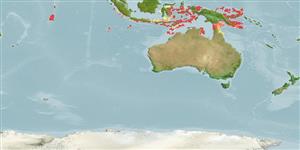Actinopterygii (ray-finned fishes) >
Perciformes (Perch-likes) >
Caesionidae (Fusiliers) > Caesioninae
Etymology: Pterocaesio: Greek, pteron = wing, fin + Latin, caesius = blue grey (Ref. 45335).
Environment / Climate / Range
Ecology
Marine; reef-associated; non-migratory; depth range 0 - 50 m (Ref. 90102). Tropical, preferred ?; 0°S - 15°S, 68°E - 154°E (Ref. 402)
Indian Ocean: Chagos Archipelago to Christmas and Cocos-Keeling islands. Western Central Pacific: Papua New Guinea, Philippines (Ref. 43437, 53416, 57038, 59110). Reports from the Comoros in western Indian Ocean (Ref. 4517) is being confirmed.
Size / Weight / Age
Maturity: Lm ? range ? - ? cm
Max length : 23.0 cm TL male/unsexed; (Ref. 90102); common length : 11.4 cm SL male/unsexed; (Ref. 37816)
Dorsal
spines
(total): 10;
Dorsal
soft rays
(total): 14-16;
Anal
spines: 3;
Anal
soft rays: 12 - 13. Body bluish or reddish dorsally, lighter ventrally. 4-5 cheek scales; 23-30 predorsal scales; scaled dorsal and anal fins; confluent Supra-temporal band of scales at dorsal midline. Upper peduncular scale rows 12-14; lower peduncular scale rows usually 16-17 (15-17). Post maxillary processes 2; posterior end of maxilla tapered. A small flat process on either side of ventrolateral surface of basioccipital, projection not ventrally far from ventral rim of condyle (Ref. 1723). Caudal fin lobes with dark tips. Head length 3.1-3.7 in SL; body depth 4.1-5.3 in SL (Ref. 90102).
Inhabits coastal, lagoon, and seaward areas around coral reefs (Ref. 90102). Feeds on zooplankton in midwater aggregations. Oviparous, with numerous, small pelagic eggs (Ref. 402). Maximum length observed in the field estimated at about 20-25 cm TL (Ref. 74965).
Life cycle and mating behavior
Maturity | Reproduction | Spawning | Eggs | Fecundity | Larvae
Carpenter, K.E., 1987. Revision of the Indo-Pacific fish family Caesionidae (Lutjanoidea), with descriptions of five new species. Indo-Pac. Fish. (15):56 p. (Ref. 1723)
IUCN Red List Status (Ref. 115185)
CITES (Ref. 94142)
Not Evaluated
Threat to humans
Harmless
Human uses
Fisheries: subsistence fisheries
More information
ReferencesAquacultureAquaculture profileStrainsGeneticsAllele frequenciesHeritabilityDiseasesProcessingMass conversion
Tools
Can't connect to MySQL database fbquizv2. Errorcode: Too many connections
